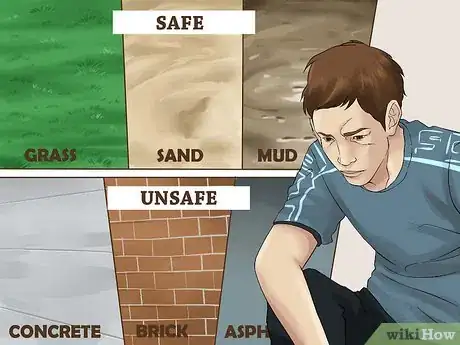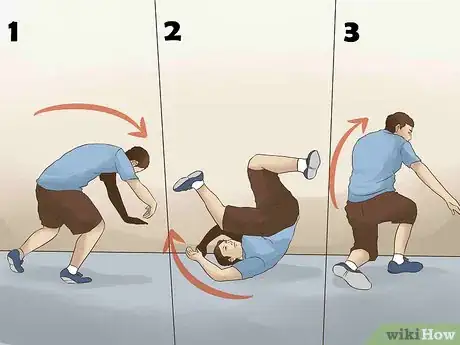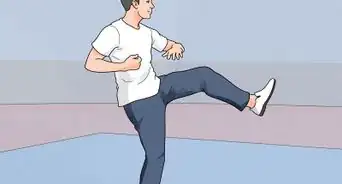This article was co-authored by Dean Theriot. Dean Theriot is a Personal Trainer and the Owner of Timberline Fitness in Houston, Texas. With over 25 years of experience in the fitness industry, Dean specializes in personal, group, and sport-specific training. Dean holds a BS in Exercise Physiology from LSU. Dean combines resistance and cardiovascular training with pilates exercises for comprehensive workouts for his clients. His sport-specific training includes football, basketball, and baseball.
There are 16 references cited in this article, which can be found at the bottom of the page.
This article has been viewed 294,772 times.
Jumping is an essential part of sports and fitness. Knowing how to properly land a jump can mean the difference between failure and success in a sporting competition. Knowing how to jump from a higher place doesn't just relate to games, however. There can be life-or-death scenarios that demand you execute a proper leap. Knowing the ins and outs of proper jumping as well as keeping your body in good shape will help maximize your success with it in the future.
Steps
Getting Ready to Jump
-
1Consider the safety of the height. While height is just one of the factors that dictates the safety of a fall (along with falling surface and jump form) it is something you should take into consideration while you plan your jump. Falling from a height of 10 feet or more can result in serious, life-long injury or even death.[1]
- If you participate in a sport that requires jumping from great heights, then work up to this gradually and take all of the necessary safety precautions. You should also be aware that repeatedly landing jumps from a great height can be as damaging to your spine as getting hit in the head is to your brain.
- There have been a few recorded cases of people falling thousands of feet and surviving. Don't use this as an example to go by, however. These are considered miraculous exceptions for a good reason.
-
2Find a soft surface to jump down to.[2] Whether you're jumping down for fun or in an emergency, the surface you're landing on will have a huge effect on the landing itself. Softer surfaces are always preferable to hard ones, as they'll help absorb some of the shock of the land.
- Grass, sand and mud are good places to fall to. Concrete, on the other hand, is about as unforgiving as it gets.
- Surfaces with a lot of degree can pose an extra threat. Landing onto an otherwise soft area with pine needles would result in a different (but similarly intense) sort of pain.
Advertisement -
3Wear shoes with shock absorption. If you have time to prepare for your jump, you should make sure to wear something on your feet that will help to cushion the force. If you're aiming for a proper landing on your feet, you run the risk of hurting them without something to ease the shock. Most sports sneakers include this technology in some form.
- Shoes with a strong grip help if there's any risk of slipping during your fall.
-
4Try to relax.[3] While it may seem counter-intuitive if you're getting ready for a big jump, it is important to relax a much as you can. If you get needlessly frustrated, your joints will tense up. This increases the risk of potential injury. If you've got the time to spare, try looking at yourself in the mirror and tell yourself everything will be okay.
-
5Lower yourself as much as possible.[4] There may be unfortunate occasions where you need to land a high jump in an emergency and aren't doing it for athletic sport. If this is the case, you'll want to be as practical as possible. Look around you, and try to see if there are any opportunities to get yourself lower to the ground.
- Holding yourself off a ledge can get you 6 feet closer to the ground. This difference in altitude can mean a lot with regards to potential injury.[5]
-
6Get a friend to keep watch.[6] A friend is good to have around because he can watch your jump and tell you how it looks. It goes without saying that having a friend watching over you is more helpful if he's already got some fitness knowledge. Perhaps more importantly, the presence of someone nearby will ensure the quickest call for medical attention if you need it for whatever reason.
-
7Warm up before your jump.[7] Squats and stretches should be done in the minutes before your jump. Even if it's not enough time to train, the act of going through a bit of a moderate workout will loosen up your joints and get your body into the proper momentum for strain.
-
8Pinpoint the landing target. As you're about to jump, make a point of spotting the place you would like to land. Having a specific place on the ground below you will increase your stability. If you're only aiming for a broad area, you're more likely to lose concentration.
Executing Your Jump
-
1Run through a mock-jump. Although you should have already warmed up by this point, you can go through a mock jump right before you make the actual leap. Many athletic jumpers use a mock run-through in the seconds before as a way to build up momentum. You should do the same as you count down to your leap. Use these final moments as an opportunity to check everything you're doing with your jump set-up.
-
2Jump towards your target. In a jump down to a lower place, you won't want to jump much higher than you already are. Get just enough force to earn you the proper stance and momentum. Keep your elbows close to your body, and tuck your chin in close to your neck.[8] Bend your knees and lunge forward however much you need to. All of this will minimize potential injury.
- For the sake of keeping your body straight, keep your eyes fixed forward. This will keep your body from going imbalanced in mid-jump.
- Some people may freak out if they see themselves dropping a far-enough distance, so if you're queasy, it's best to keep your eyes off the ground.
-
3Hold your form. A proper athletic jump should end in the same stance as it began. Do your best to keep your body straight. Even in freefall, it's important to keep your stance straight and stable. Letting your limbs go wild will increase the risk of injury.
-
4Spare room for flexibility. Giving your body the freedom to adjust as you meet the ground is essential for preventing injury.[11] Don't lock your knees at any point, and give your muscles the limberness they'll need to counter the force of the land.
-
5Allow your body to go limp. If your body is "soft" (rather than tensed), you'll be able to react naturally to a landing. This is a natural way of minimizing potential damage in a fall.[14] With this said, it's a good idea to try to make yourself as relaxed as possible before you set into your jump.
- Try to strike a balance between going limp and holding your proper form.
-
6Land on both feet.[15] In any type of jump, landing on one foot effectively doubles the amount of pressure on that foot. Do your best to keep your legs and feet together throughout the jump. This will maximize the chances of your feet hitting the ground at the same time. Landing on both feet is more important if your jump is high enough. An imbalanced fall can result in severe injury.
- Don't try to break your fall with your hands. Hands can alleviate some of the shock on your feet, but they can generally withstand only a fraction of the pressure that feet can.[16]
- When you land, try to land on the balls of your feet, shoulder-width apart.
- Bend your knees and keep them flexible as you hit the ground to help absorb some of the impact.[17]
-
7Perfect a landing roll. It's not just a thing for action movies. A landing roll is arguably the best way of absorbing shock from a fall. If you're landing from a height, you should aim for a diagonal roll. Pushing yourself into a roll with one foot will avoid placing stress on your spine.[18] As you fall, aim a shoulder to the ground in the direction you want to roll in. As you're rolling, take a foot and hit the ground with it to give you the extra force you need to complete the roll.
- Rolls are difficult to master and should be left to trained athletes. It should be said as a high-difficulty alternative to landing on both feet.
- Try rolling on both sides. It's a good habit for athletic versatility, and you may find you prefer one side over the other.[19]
- For practice, regular "gymnastics rolls" (without a jump) will get you used to the experience of rolling. They're relatively easy to do provided you have a degree of fitness and flexibility. If you want to practice with diagonal rolls, a playground (with a soft ground) is a good place to start.[20]
- Rolls lead well into continued movement. This is why they're so highly recommended in sports like parkour.
Optimizing Your Body
-
1Do squats.[21] Squats are a great go-to exercise. They're relatively cheap and easy to do anywhere, but they target a lot of muscles that aren't typically worked out. To squat, bend your knees as low as you can while you keep your back perfectly straight. Hold your place for 30 seconds, then release and try again.
- Squats are remarkably challenging at first if you're unused to them. However, your body will train up fast.
-
2Work plyometrics into your exercise routine. Plyometrics refer to a series of exercises intended to balance out the use of muscles in your legs. Because people are usually sitting down in their jobs, the sedentary behaviour trains the legs to depend on knees instead of glutes. Plyometrics aims to reverse this.[22]
- Make a sequence of tiny jumps, only a couple inches off the ground. Try to make your landings as quiet and soft as possible.[23]
- Shift your body's weight around on your heels, keeping your knees behind your toes throughout the movement.
-
3Get enough sleep.[24] Most people aim to get by with 5 or 6 hours per night. This is short of the recommended 7-9 hour routine. Athletes should arguably be sleeping 9-10 hours in order to accommodate for all of the wear and tear the body goes through from regular practice. If you're not giving yourself enough sleep, you're putting a major curb on your jump potential.
-
4Stay hydrated.[25] Water is a necessary thing for the body to function, and you tend to need more of it when you're exercising. In the case of jumping, water is essential to keep the joints fluid and limber. Keep a refillable bottle of water whenever you're planning to train or jump. Drink it whenever you get a break.
- Don't drink so much water that you end up feeling bloated. The feeling doesn't last forever, but it is uncomfortable and limits your training for a while.
-
5Take your training slowly.[26] If you're lucky enough to be jumping for fun rather than necessity, you should take advantage of the fact that you can learn at your own pace. Start with small heights, and gradually work your way forward. The process may not be as glamorous as with taking the biggest jumps from the start, but it is more effective in terms of raw learning.
-
6Keep practicing.[27] Jumping can be a lot of fun. Even if you consider yourself properly trained at a certain point, there's a lot of value in continuing to practice. Because something like jumping depends on a lot of various factors like distance, height and weight, the particulars will be different each time you try it. Over time, you'll get a sharper understanding of how your body is best used with a jump.
Expert Q&A
-
QuestionCan I jump down from 11 feet?
 Michele DolanMichele Dolan is a BCRPA certified Personal Trainer in British Columbia. She has been a personal trainer and fitness instructor since 2002.
Michele DolanMichele Dolan is a BCRPA certified Personal Trainer in British Columbia. She has been a personal trainer and fitness instructor since 2002.
Certified Fitness Trainer No. You could die or become seriously injured. If you are practicing jumping for some event or parkour, make sure the surface you land on is soft and I recommend you don't jump more than your own height.
No. You could die or become seriously injured. If you are practicing jumping for some event or parkour, make sure the surface you land on is soft and I recommend you don't jump more than your own height. -
QuestionAre wood chips a good place to land and roll?
 Michele DolanMichele Dolan is a BCRPA certified Personal Trainer in British Columbia. She has been a personal trainer and fitness instructor since 2002.
Michele DolanMichele Dolan is a BCRPA certified Personal Trainer in British Columbia. She has been a personal trainer and fitness instructor since 2002.
Certified Fitness Trainer Yes, as long as they are 8 inches deep or deeper. Wood chips are considered a safer landing surface than grass, gravel or dirt.
Yes, as long as they are 8 inches deep or deeper. Wood chips are considered a safer landing surface than grass, gravel or dirt. -
QuestionHow do you know what height to jump from first?
 Community AnswerYou should jump from whatever height you feel comfortable with. Start with a lower height and work your way up.
Community AnswerYou should jump from whatever height you feel comfortable with. Start with a lower height and work your way up.
Warnings
- Keep your mouth closed while you jump. The shock of the landing can put you at risk of biting through your tongue if your mouth is open.⧼thumbs_response⧽
- Don't jump from a high place if you don't need to. Jumping from the door of a semi-truck, for instance, can cause as much shock as 7 times your body weight.[28]⧼thumbs_response⧽
References
- ↑ https://www.theguardian.com/science/2004/may/20/thisweekssciencequestions2
- ↑ http://www.realworldsurvivor.com/2015/11/19/how-to-escape-a-high-rise-building-during-an-emergency/#how-to-escape-a-high-rise-building-during-an-emergency-3
- ↑ http://www.outsideonline.com/1920216/how-fall-right
- ↑ http://www.realworldsurvivor.com/2015/11/19/how-to-escape-a-high-rise-building-during-an-emergency/#how-to-escape-a-high-rise-building-during-an-emergency-3
- ↑ http://www.realworldsurvivor.com/2015/11/19/how-to-escape-a-high-rise-building-during-an-emergency/#how-to-escape-a-high-rise-building-during-an-emergency-3
- ↑ http://www.tourismontheedge.com/travel-inspired/tips-tricks/10-tips-on-how-to-cliff-jump-without-getting-hurt
- ↑ http://breakingmuscle.com/strength-conditioning/dynamic-warm-up-increases-jump-height-and-distance
- ↑ http://www.realworldsurvivor.com/2015/11/19/how-to-escape-a-high-rise-building-during-an-emergency/#how-to-escape-a-high-rise-building-during-an-emergency-3
- ↑ http://www.realworldsurvivor.com/2015/11/19/how-to-escape-a-high-rise-building-during-an-emergency/#how-to-escape-a-high-rise-building-during-an-emergency-3
- ↑ http://breakingmuscle.com/parkour/lessons-in-parkour-how-to-safely-land-on-your-feet
- ↑ http://breakingmuscle.com/parkour/lessons-in-parkour-how-to-safely-land-on-your-feet
- ↑ http://www.artofmanliness.com/2013/07/19/beginners-guide-to-parkour/
- ↑ http://breakingmuscle.com/parkour/lessons-in-parkour-how-to-safely-land-on-your-feet
- ↑ http://ucanr.edu/sites/ucehs/files/182274.pdf
- ↑ http://www.artofmanliness.com/2013/07/19/beginners-guide-to-parkour/
- ↑ http://ucanr.edu/sites/ucehs/files/182274.pdf
- ↑ Dean Theriot. Personal Trainer. Expert Interview. 22 January 2021.
- ↑ http://breakingmuscle.com/parkour/how-do-you-roll-gymnastics-vs-parkour
- ↑ http://breakingmuscle.com/parkour/how-do-you-roll-gymnastics-vs-parkour
- ↑ http://breakingmuscle.com/parkour/how-do-you-roll-gymnastics-vs-parkour
- ↑ http://breakingmuscle.com/parkour/lessons-in-parkour-how-to-safely-land-on-your-feet
- ↑ http://sportsmedicine.about.com/od/Lower-Body-Exercises/a/How-To-Safely-Land-A-Jump.htm
- ↑ http://sportsmedicine.about.com/od/Lower-Body-Exercises/a/How-To-Safely-Land-A-Jump.htm
- ↑ http://www.webmd.com/sleep-disorders/guide/sleep-requirements
- ↑ http://www.webmd.com/diet/6-reasons-to-drink-water
- ↑ http://www.artofmanliness.com/2013/07/19/beginners-guide-to-parkour/
- ↑ http://www.climbing.com/skills/how-to-fall/
- ↑ https://www.ihsa.ca/pdfs/magazine/volume_13_Issue_2/Dont_jump_down.pdf
About This Article
To land a jump from a high place, first warm up with some stretches to loosen your joints and minimize the risk of injury. Aim to land on a soft surface, like grass, sand, or mud, if you can. If you’re jumping in an emergency, lower yourself down from a ledge to reduce the distance, and drop down. If you’re jumping for parkour, bend your knees and lunge off the edge. Try to jump straight, instead of upwards, so you don’t add any more height to the jump. When you land, let your knees bend so your whole body can absorb the shock. If you know how to roll, safely roll over one shoulder to distribute even more of the impact. For more tips from our Personal Training co-author, including how to train your body for jumping from high places, read on!


















































































